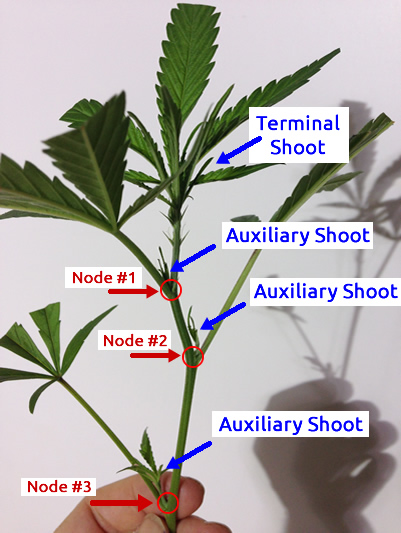You must have heard the expression Like father, like son or Like mother, like daughter when a child greatly resembles a parent in character or behavior.
Did you know that the saying can also be applied to weed, particularly cloned weed?
Cannabis plants can reproduce sexually and asexually. Sexual reproduction is when two parent plants cross in the process called pollination, after which the female plant produces buds that contain seeds. You plant the seeds and wait for young sprouts to appear, and each new plant “born” this way has unique features.
With asexual reproduction, you don’t need to wait and collect seeds. What you need is only one grown-up cannabis plant, usually the mother. You take a cutting (called explant) from this plant, plant it in a rooting medium, and help it grow into another young plant.
That is called cloning. The young plant “born” this way will be an exact replica of its parent.
If you are thinking about cloning weed but you are at the beginning of the road, you will appreciate the following information. Let’s start.
It’s all about genetics
Sometimes what you don’t like about your parents, you detect in yourself. It can be annoying. But you can’t run away from yourself. At most, you can work on a trait, but not eradicate it completely.
In the botany world, you have much more control. You can stimulate and preserve good traits in your plants. How? One way to do it is through cloning.
We’ve seen movies about cloning humans, but what exactly is cloning when it comes to plants?
As we briefly mentioned, it is a process of cutting off a small secondary branch from a healthy mother. It is best to cut a branch containing the terminal shoot and at least one node below it.

The goal is to create an identical copy that will become a young plant with the exact features of the parent plant; in this case, a young cannabis plant.
If you have a bud that you like a lot, you may want to clone it to preserve a strain.
Cloning is possible because of meristematic cells. They are a special type of undifferentiated cells that, unlike other cells with a defined function, keep dividing and helping the plant grow.
Then environmental conditions determine what sorts of cells they turn into – shoots and foliage, root cells or trunk.
Why cloning?
Every time you grow a new plant using the seed, you are changing the genetics of your harvest to something different. These changes can be welcome or unwelcome.
Cloning, on the other hand, keeps your crop genetically intact. You don’t need to hope for the desired strain – you know you will have it because the daughter plant will be identical to the mother plant.
Important note: A cutting from a female will be female, and a cutting from a male will be a male plant.
Apart from being able to control the genetics of your next plant, cloning carries other benefits to the table:
- It saves you money. You don’t need to buy seeds. You multiply the plants of your beloved strain without extra investing.
- Cloning saves you time. You don’t need to wait for shoots to come from the seed, you just wait for the roots to develop into a baby plant. This “baby” plant will actually be the same age as its mother, so it will flower to the mature stage very quickly – much faster than it would take a real “baby” plant to grow.
- Clones make your garden more stable and sustainable. From generation to generation, you preserve the desired garden quality.
- You don’t need to customize the environmental conditions, either.
Of course, after some time you may want to grow seeds for some unpredicted scenario. It is always good to have a plan B.
One disadvantage of cloning is that since you overstep the genetic variation (changes in DNK that occur with each generation and result in plant diversity), your plants may be more vulnerable to pests or environmental factors. So make sure you take good care of them.
What you will need to clone your cannabis plant
- A clean table to work on
- A sharp instrument for cutting, such as a scalpel or razor blade
- A rooting hormone (there are natural ones on the market)
- A rooting medium
- A cloning tray where you will store your “babies”
Note that cuttings are very sensitive to bacteria, so make sure your working equipment is very clean.
When to start cloning weed plants
In order to become skillful in cloning, you don’t need a master’s degree in botany. Love for the plants and the old-fashioned growing experience will be sufficient.
The best time to take clones from a mother plant is a phase when the plant is in the vegetative growth stage, about two months into the cycle.
Once the flowering starts, much of the plant’s energy goes to the production of the flower. You want to avoid this.
When choosing a mother plant, look for a strong, healthy plant, because you will replicate those same traits in the new plant. You want the best attributes in your clones.
Handle with care
The clone is much like a baby. In order to live independently from its parent, it needs to grow roots. So when you take a clone, immediately place the cut end into the water.
It has to be ”incubated” in the water in order to avoid wilting, or in a worst-case scenario, verticillium wilt. But do not leave them in the water too long, they need oxygen.
The process of cloning
- Make sure that your working environment is sterile. When you do the cuttings, you act like a surgeon and the mother and daughter plants are sensitive in the process, as we mentioned before. Make an environment that is free from any potential infection. Sanitize your tools.
- Do not fertilize your plants within the days before you take your cuttings.
Remember, you want your cuttings to start to grow roots. Avoid anything that can slow down or jeopardize the process. For example, nitrogen from fertilizers can trick your clones to grow vegetation instead of roots.
How to take the cuttings
- Don’t cut the branches from the bottom, they are less productive. Make sure they are long enough, they should have at least one node below the top.
- Choose a stem with larger leaves. This will promote faster rooting.
- Make sure each cutting, or explant, includes at least one growth tip and a stem section. The growth tip is important since it will grow into the upper part of the mature plant. The stem, properly coaxed, will develop roots.
- Cut the branch at an angle, as you would with fresh flowers before you put them in a vase. This is important because it helps the stem absorb more water and nutrients.
- Use sharp tools, like pruner or scalpel. You don’t want to crush or squeeze the stem. This would make the root formation harder.
- Place the freshly cut stems immediately in the water. We already mentioned why this is important.
Final steps after cutting the stems
Now you are ready for the final steps that will help your clones become healthy young plants.
You want your new branches to grow in optimal conditions in order to have proper photosynthesis and just the right transpiration rate. If you are growing cannabis indoors, you should make sure the temperature and humidity conditions are stable.
The number and size of the plant’s leaves also influence its transpiration rate.
That is why, after taking the stem out of the water, you should clip the leaves, or cut the edges about 50% of their size. Also, you don’t want the leaves to touch the growing media or other leaves. It can lead to the formation of mold or fungi.
Now you are ready for the next step. Some choose to dip the stem in a rooting hormone. There are many on the market, so do thorough research before choosing.
After you shortly dipped the stem in the hormone, transfer your baby plant into your rooting medium.
Types of rooting medium
A rooting medium is a substrate consisting of organic components and minerals that promotes root growth.
There are three main media. Each has its pros and cons. Choose the one that you, as a beginner, are most comfortable with.
The important thing is that your “babies” get enough humidity and light, preferably 18 hours.
Make sure there is plenty of air in the rooting media because it stimulates root growth.
Soil/Compost – You can grow your plants in organic composted living soil or cannabis-friendly soil mix. It is usually rich in nutrients so, during the first few weeks of the plant’s growth, you just need to add water. Later, as your plants get older, you will need to add nutrients in the water.
Soilless Mix – As its name says, it is a growing mix without soil and is composed of ingredients like coco coir, perlite, peat moss, rockwool. Its main difference from the soil growing is that you put all the needed nutrients in the water.
Water or Hydroponics – This is also a method of growing cannabis without soil, but with the roots directly placed in water that contains mineral nutrients. This way you can achieve the fastest growth possible.
Transplanting to get a garden of clones
As your weed grows, you will need to transfer it to larger containers to ensure that the roots have plenty of room.
Otherwise, they’ll start ”circling” around the edges of the container and will be unable to get the adequate ratio of oxygen, water, and nutrients. Then you can end up with all kinds of root problems.
Some botanists suggest that a plant is ready to be transplanted when its leaves reach the edges of the container. It is certainly better to do it sooner than later, or just when you notice that the roots have filled the container.
Keep in mind that the transplanting is a shock for the plant, so be as gentle and careful as you can. Take all the necessary steps to make this process smooth – water the cannabis plant a few days before and after transplanting, make sure you don’t transplant it during the flowering phase, avoid direct sunlight, etc.
After you’ve transplanted all your clones, and have given them the right care, soon you will be proud of your garden.
When two whitish or pink hairs show up on your daughter clones, you will happily say, “Like mother, like daughter”.





Maxcatski November 9, 2019 at 4:18 pm
There was no mention in this article on whether it's better to keep mother plants or to clone from generation to generation. I grow continuously with plants in flower and vegetation at the same time. I clone from generation to generation and do not keep mother plants. This allows me to grow more different phenotypes and strains. And I typically use bottom branches for clones. These work well and they're going to be pruned off anyway!
Maxcatski November 9, 2019 at 4:30 pm
I clone into rockwool (Grodan) cubes with a good success rate. The cubes are then transplanted into soilless mix after they pop roots. Always trim your clones underwater to prevent air bubbles and wilting off. I also gently score a few times above the angled cut to promote root growth. Get growing!